
-
Select format
-
- Publisher:
- Cambridge University Press
- Publication date:
- January 2019
- January 2019
- ISBN:
- 9781108649131
- 9781108491877
- 9781108740746
- Dimensions:
- (228 x 152 mm)
- Weight & Pages:
- 0.53kg, 276 Pages
- Dimensions:
- (229 x 152 mm)
- Weight & Pages:
- 0.427kg, 284 Pages
You may already have access via personal or institutional login
Book description
We are fascinated by what words sound like. This fascination also drives us to search for meaning in sound - thereby contradicting the principle of the arbitrariness of the linguistic sign. Phonesthemes, onomatopoeia or rhyming compounds all share the property of carrying meaning by virtue of what they sound like, simply because language users establish an association between form and meaning. By drawing on a wide array of examples, ranging from conventionalized words and expressions to brand names and slogans, this book offers a comprehensive account of the role that sound symbolism and rhyme/alliteration plays in English, and by doing so, advocates a more relaxed view of the category 'morpheme' that is able to incorporate less regular word-formation processes.
Reviews
'Rejecting the long dominant Saussurean view that language consists very largely of arbitrary sound-meaning associations and is primarily designed for the communication of referential meaning, Benczes takes us on a richly illustrated journey into a world of interrelated English word forms and of meanings affected by sounds and sound patterns. These lexical interactions are the expressive source of everyday language that serves to entertain, arouse, soothe and instruct as much as to inform. This is a book to tickle the reader’s fancy, tempting us to try our own hand at discovering such phenomena as onomatopoeia and phonesthemes, rhyming compounds and irreversible binomials. These unconscious influences between form and meaning and form and form are all ways in which our language is continually shaped by what we already know - information essential for anyone concerned with first or second language learning or simply with delving more deeply into the nature of language.'
Marilyn Vihman - University of York
Contents
Metrics
Altmetric attention score
Full text views
Full text views help Loading metrics...
Loading metrics...
* Views captured on Cambridge Core between #date#. This data will be updated every 24 hours.
Usage data cannot currently be displayed.
Accessibility standard: Unknown
Why this information is here
This section outlines the accessibility features of this content - including support for screen readers, full keyboard navigation and high-contrast display options. This may not be relevant for you.
Accessibility Information
Accessibility compliance for the PDF of this book is currently unknown and may be updated in the future.


